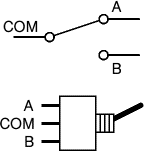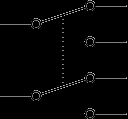FAQ
What is a Push Button Switch?
What is a Push Button switch? Push Button Switches consist of a simple electric switch mechanism which controls some aspect of a machine or a process. Buttons are typically made out of hard material such as plastic or metal. The surface is usually shaped to accommodate the human finger or hand, so the electronic switch can be easily depressed or pushed. Also, most Push Button Switches are also known as biased switches. A biased switch, can be also considered what we call a "momentary switch" where the user will push-for "on" or push-for "off" type. This is also known as a push-to-make (SPST Momentary) or push-to break (SPST Momentary) mechanism.
Pushbutton switches are mechanical switches defined by the method used to activate the switch. The activation method is typically in the form of a plunger that is pushed down to open or close the switch
Switches with the "push-to-make" (normally-open or NO) mechanism are a type of push button electrical switch that operates by the switch making contact with the electronic system when the button is pressed and breaks the current process when the button is released. An example of this is a keyboard button.
A "push-to-break" (or normally-closed or NC) electronic switch, on the other hand, breaks contact when the button is pressed and makes contact when it is released.
Switching Mechanism
There are several pole and throw configurations for pushbutton switches. The number of switch contact sets used is known as the number of poles and the number of conducting positions (single or double) is referred to as the throw. Switching mechanisms function differently by type; the five types of switches are described below:
- Single pole single throw (SPST) is a switch that makes or breaks the connection of a single conductor in a single branch circuit. This switch typically has two terminals. It is commonly referred to as asimple on-off switch and can be used to switch the power supply to a circuit.
![]()
On-Off switch circuit symbol. Image Credit: The Electronics Club
SPST switches can also work as "push-to-make" on, where when the button is released it returns to its normally open (off) position or vice-versa.
![]()
(On)-Off switch circuit symbol. Image Credit: The Electronics Club
Single pole double throw (SPDT) is a switch that makes or breaks the connection of a single conductor with either of two other single conductors. This switch typically has 3 terminals, and is commonly used in pairs and called a "Three-Way" switch.The switch can be in both on/off positions, switching on a separate device in each case. For example, a SPDT switch can be used to switch on a red lamp in one position and a green lamp in another position. Special versions can have a third switch position which turns both circuits off.

On-On switch circuit. Image Credit: The Electronics Club
- Double pole single throw (DPST) is a switch that makes or breaks the connection of two circuit conductors in a single branch circuit. This switch typically has four terminals. The pair of on-off switches operate together and it is often used to switch the main electricity because it can isolate both the live and neutral connections.

On-Off switch circuit. Image Credit: The Electronics Club
- Double pole double throw (DPDT) is a switch that makes or breaks the connection of two conductors to two separate circuits. This switch typically has six terminals and is available in both momentary and maintained contact versions.It can be wired up as a reversing switch for a motor and special versions can include a center off position.


On-On switch circuit; Wiring for Reversing Switch.
Image Credit: The Electronics Club
- Solid-state switching mechanism includes transistors and piezoelectric materials.
Types of Push Button Switches
There are many different kinds of pushbutton switches and at Future Electronics we stock many of the most common types. We carry some of the top pushbutton switches manufacturers and suppliers including: Altech, C & K, Carling, Cherry Electric, E-Switch, EECO, Grayhill, Marquardt Switches, NKK Switches, Schurter and TE Connectivity
Best of all our electronic push button switch offering comes in a range of sizes from miniature to industrial power switches. There are even illuminated pushbutton switches available. Use our parametric filters to refine your electric push button switch search on our website. You can select by number of positions, by circuitry, by actuator style and by termination among others.
Push Button Switches Applications
Typical applications include: Calculators, push-button telephones, kitchen appliances, magnetic locks, and various other mechanical and electronic devices, home and commercial.
FAQ
Contact Us

Name: Summer
E-mail: sales@switch-connector.com
Skype: cnomten-summer
Whatsapp: +8615858506537






 Skype Chat
Skype Chat WhatsApp
WhatsApp  Mail inquiry
Mail inquiry